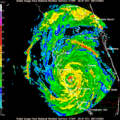Hurricane Charley facts for kids
| Category 4 major hurricane (SSHWS/NWS) | |

Hurricane Charley before landfall in Florida
|
|
| Formed | August 9, 2004 |
|---|---|
| Dissipated | August 15, 2004 |
| Highest winds | 1-minute sustained: 150 mph (240 km/h) |
| Lowest pressure | 941 mbar (hPa); 27.79 inHg |
| Damage | $16.3 billion (2004 USD) |
| Areas affected | Jamaica, Cayman Islands, Cuba, Florida, South Carolina, North Carolina |
| Part of the 2004 Atlantic hurricane season | |
Hurricane Charley was a very strong storm in the 2004 hurricane season. It was the second hurricane and the second major hurricane of that year. Charley lasted from August 9 to August 15. Its winds reached 150 miles per hour (240 km/h). This made it a Category 4 hurricane on the Saffir-Simpson Hurricane Scale.
The storm hit southwestern Florida very hard. It was the strongest hurricane to hit the United States since Hurricane Andrew, which happened twelve years before. In the United States, Hurricane Charley caused 10 deaths. It also caused about $15.4 billion in damage in 2004.
How Hurricane Charley Caused Damage
Hurricane Charley caused damage in a way that was similar to Hurricane Andrew. Most of the damage came from very strong winds. Both storms also hit land when the ocean tide was low. This helped prevent big storm surges, which are large waves that can cause a lot of damage. Both hurricanes were also quite small when they reached land.
Images for kids
-
Charley rapidly intensifying as it approached Florida on August 13
-
NEXRAD image of Hurricane Charley over Punta Gorda, Florida just after landfall
-
Charley making landfall on August 13, 2004
-
Damage in Captiva Island
-
Damage caused to a gas station by Hurricane Charley in Kissimmee, Florida.
-
President George W. Bush, aboard Marine One, surveys hurricane damage at a mobile home park in Fort Myers, Florida.
-
Aerial image of destroyed homes in Punta Gorda
-
Empty railroad hopper cars toppled over as a result of high winds from Hurricane Charley in Fort Meade
-
Hurricane Charley, just after its third US landfall in South Carolina
-
Port Charlotte, September 16, 2004. Congressman Mark Foley (right) checks out the travel trailers that FEMA provides as temporary housing
See also
 In Spanish: Huracán Charley para niños
In Spanish: Huracán Charley para niños













